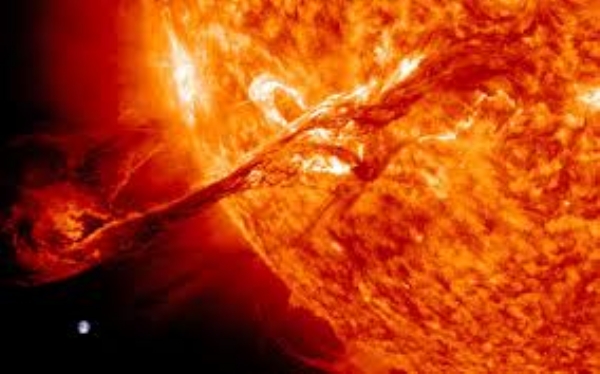Aditya L1 captures strongest solar eruption from the Sun to hit Earth in 2 decades
15 May 2024 11:41:03
India's solar mission Aditya L1 has captured the unusually strong solar storm that hit Earth on Saturday, producing stunning displays of colour in the skies across the Northern Hemisphere, the Indian Space Research Organisation (Isro) said on Tuesday.

The space agency has said that they mobilised all its observation platforms and systems to record the signatures of this event, the biggest geomagnetic storm due to solar activity in two decades. Both Aditya-L1 and Chandrayaan-2 have made observations and signatures have been analysed, Isro said in a statement.
"The ASPEX payload on-board Aditya -L1 is showing high speed solar wind, high temperature solar wind plasma and energetic ion flux till now ... Solar wind Ion Spectrometer - SWIS (a module part of the payload) has "captured the enhancement of the alpha particle and proton flux of the solar wind as a signature of this solar eruptive event," the agency said.
Proton (lower) and alpha (upper) lines are seen from the Aditya L1 observations. The prominent change in the flux is noticed as the signature of this solar eruptive event. (Photo: Isro)
Aditya L1's SupraThermal and Energetic Particle Spectrometer (STEPS) also measured the flux of the solar wind ions at seven energy ranges. "A steady rise in the energetic ion fluxes during the event has been noticed," the agency added.
"The X-ray payloads on-board Aditya-L1 (SoLEXS and HEL1OS) have observed the multiple X- and M-class flares from these regions during the last few days while the in-situ magnetometer (MAG) payload has also observed the events as it passed by the L1 point," Isro further explained.
Aditya L1 has captured the signatures of the X-class flares in the soft X-Ray regime. (Graph: Isro)
According to the agency, this is the biggest Geomagnetic storm since 2003 in terms of its strength, as the flaring region on the Sun was as big as the historically important Carrington event that took place in 1859.
"Multiple X-class flares and CMEs have hit the earth in the past few days. This had severe effects over high latitudes where trans-polar flights are already being reported to get diverted," Isro said, adding that "More events are expected in the next few days".
The main hit of the storm happened in the early morning of May 11, when the ionosphere had not developed fully, but the Indian sector got less affected. Being at lower latitudes, widespread outages haven't been reported in India
